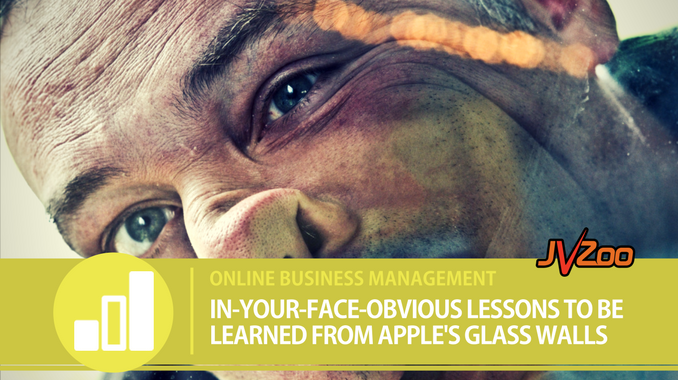As you may have heard, Apple has a fancy, new office in Cupertino. The office features glass walls and employees there have reportedly been walking face-first right into them. As funny as that image may be, there are valuable business lessons we can learn from this.
Lesson 1: “When walking, walk. When eating, eat,” – Zen proverb
The first thing that you may have noticed was that the reports say Apple employees (like many people) are often glued to their smartphones. When you’re walking with your face in your phone, you’re probably going to miss things. Those things won’t always be as obvious as a wall to the face, but that doesn’t mean you should ignore them.
Multitasking is a bad idea. It doesn’t work. If it did, we wouldn’t have problems with people texting while driving (or looking at their iPhones while walking near glass walls). The fact of the matter is, when you do multiple things at once, you aren’t doing any of them justice. How many times have you checked your e-mail while on a call only to lose track of what is happening in your conversation?
Lesson 2: “It’s the punch you don’t see coming that really gets you.” – Unknown
In business as in life, there are things you expect and things you don’t. The thing is, you need to be ready for both. It’s easy to focus on – and prepare for – the things you expect. The challenge is trying to figure out what you’re not expecting or at least to keep your eyes open so that you’ll see it when it comes.
Succession planning falls into the “foreseeable” category. Most leaders know how important it is, but just as many people don’t save for a rainy day, many companies don’t plan for succession. Take stock of the skills in your organization and make sure you have (or develop) back-ups. That genius software developer you have? What happens if she wins the lottery and moves to Aruba? What if she gets hit by a bus tomorrow? Start planning.
Another good rule of thumb is to make sure there are always at least 2 people who know how to do a particular job on staff. Have procedures in place where if one of your team members becomes sick, or must take a leave of absence, another team member can seamlessly step in to fulfill their duties while they are away.
Handling the unexpected is trickier. These are the punches you don’t see. They might be obvious in retrospect, but they’re difficult to spot in the moment. Consider Blockbuster or Barnes & Noble in the age of Netflix and Amazon. Both companies were well positioned to deal with competitors, but neither one was ready for such fundamental shifts in their respective industries.
Lesson 3: “Design is not just what it looks like and feels like. Design is how it works.” – Steve Jobs
What is a wall? At its simplest, it’s a barrier that breaks up space, turning one room into two.
What does a wall look like? That depends. Walls can be made of many different materials; wood, stone, brick, plaster, even metal. What a wall doesn’t look like is a door, or a window, or nothing at all – unless it happens to be a wall in Apple’s new building.
A key concept in usability and user experience (or UX) design is that the design of an object should make its function intuitive. Think about those doors that have a push bar on one side and a pull handle on the other. How would you open them if the handles were the same on each side (and there was no “Push” or “Pull” sign on it)?
Don’t make things harder than they have to be. Like invisible walls. Apple employees even took to sticking Post-It notes on the glass doors to mark them out. It worked, but it was messy.
This could be your sales page (for example, having links that don’t look like links causing you to miss out on sales), your lead capture page (such as not double checking to see if your opt-in form works correctly), or your processes (do you really need 10 upsells or will that simply irritate your customers?).
So, what are your glass walls and what are you going to do about them? Take an honest inventory of your systems and processes & then decide what kind of simplification strategies you can employ to make your business run smoothly for you, your staff, clients, and customers.

